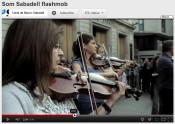Waldorf News
50 Instruments That Will Melt Your Heart

The flash mob finds its apotheosis.
When Bill Wasik came up with the idea of the flash mob back in 2003, the thing was a social experiment in the purest sense. The first event — held at Macy’s in New York City’s Herald Square — simply asked participants to meet up at bars in the vicinity of the department store, where they were given instructions about what to do during the mob itself. (In this case, the instructions were to congregate around a rug in the 9th-floor furniture department.) The gather-then-do-something-then-disperse event, and those that would follow it, weren’t necessarily meant to be social commentaries; they weren’t necessarily meant to be political gestures. They were simply meant to be a test — and, later, a demonstration — of the connective power of the Internet. Wasik wanted to see whether people themselves could go viral.
“The idea of flash mobs as being absurd and being ten minutes or less,” Wasik later explained, “sort of means that they are not very great vehicles for expression.” Instead, flash mobs themselves were “a demonstration of what the technology of Internet chain emails could do and text messaging can do and a demonstration of social networks,” he said — the movement that builds as “one person forwards it to ten people and they forward it to 10 people and before you know it you can gather really tremendous crowds.”
This all meant that flash mobs, in their earliest incarnations, were a strange mixture of meaning and nihilism. As manic and effervescent as they could be as performances, their content itself — the flash of the mob — was almost beside the point. It was the mechanism that mattered, the crowds that came together at one random place, at one random time. What the congregants did once congregated was secondary, merely the proof of the concept.
Which is why I love the video above: a flash mob that is beautiful and high-minded and entirely, entirely earnest. The performance — an iterative take on Beethoven’s “Ode to Joy,” convened in Sabadell, Spain — takes the original purpose of the flash mob and reverses it: Instead of assembly > content, here’s it’s the content that matters much more than the congregation. The gathering’s subject has a predicate, which is to create — and to share — art.
The years between 2003 and our current moment have seen the evolution of the flash mob: from cheeky, satiric events to gatherings that are deeply rehearsed and occasionally — inevitably — commercial. (Even the Sabadell video is commercial: Its performance was convened to mark the 130th anniversary of its Banco Sabadell.) But this mob, and this particular “Ode to Joy,” are something else: a crowd that comes together not primarily to make a point, but simply to make music. Together.
This article comes to us from theatlantic.com. To view the article at source click here.
 Flexible preparation for your new grade
Flexible preparation for your new grade Great books for Waldorf Teachers & Families
Great books for Waldorf Teachers & Families Association for a Healing Education
Association for a Healing Education Train to Teach in Seattle
Train to Teach in Seattle Caring for All Stages of Life
Caring for All Stages of Life The Journey is Everything
The Journey is Everything Middle School Science With Roberto Trostli
Middle School Science With Roberto Trostli Transforming Voices Worldwide
Transforming Voices Worldwide
 Quality Education in the Heartland
Quality Education in the Heartland Full-Time Teacher Education
Full-Time Teacher Education Waldorf-inspired Homeschool Curriculum
Waldorf-inspired Homeschool Curriculum Everything a Teacher Needs
Everything a Teacher Needs Jamie York Books, Resources, Workshops
Jamie York Books, Resources, Workshops Apply Today: New Cohort Starts Nov. 2025
Apply Today: New Cohort Starts Nov. 2025 Bay Area Teacher Training
Bay Area Teacher Training ~ Ensoul Your World With Color ~
~ Ensoul Your World With Color ~ Immersive Academics and Arts
Immersive Academics and Arts Roadmap to Literacy Books & Courses
Roadmap to Literacy Books & Courses Space speaks. Its language is movement.
Space speaks. Its language is movement. Summer Programs - Culminating Class Trips
Summer Programs - Culminating Class Trips Bringing Love to Learning for a Lifetime
Bringing Love to Learning for a Lifetime Waldorf Training in Australia
Waldorf Training in Australia RSS Feeds
RSS Feeds